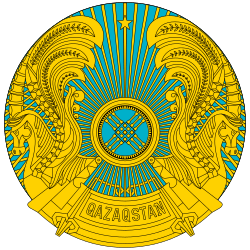Transport in Kazakhstan
The vast territory of Kazakhstan spans across 2,700,000 km2 (1,000,000 sq mi). The population density is low in Kazakhstan, and the centers of industry and agriculture are spread out and remote from world markets.
Kazakhstan is committed to regional infrastructure development.[1] According to the Kazakhstan Ambassador to the U.S., Kairat Umarov, Kazakhstan invested $18 billion in construction of airports, highways, and railroads in 2014.[1]
Railways
Railways provide 68% of all cargo and passenger traffic to over 57% of the country. There are 15,333 km (9,527 mi) in common carrier service, excluding industrial lines.[2] All railway lines in Kazakhstan are built in 1,520 mm (4 ft 11 27⁄32 in) gauge, of which 4,000 km (2,500 mi) is electrified (2012).[2]
Kazakhstan Temir Zholy (KTZ) is the national railway company. KTZ cooperates with French loco manufacturer Alstom in developing Kazakhstan's railway infrastructure. Alstom has more than 600 staff and two joint ventures with KTZ and its subsidiary in Kazakhstan.[3] In July 2017, Alstom opened its first locomotive repairing center in Kazakhstan. It is the only repairing center in Central Asia and the Caucasus.[4]
As the Kazakhstani rail system was designed during the Soviet era, rail routes were designed ignoring inter-Soviet borders, based on the needs of Soviet planning. This has caused anomalies, such as the route from Oral to Aktobe passing briefly through Russian territory. It also means that routes might not suit modern-day Kazakhstani needs.[5]
Astana Nurly Zhol railway station, the most modern railway station in Kazakhstan, was opened in Nur-Sultan on 31 May 2017. The opening of the station coincided with the start of the Expo 2017 international exhibition. According to the KTZ, the 120,000 m2 (12 ha) station is expected to be used by 54 trains a day and has capacity to handle 35,000 passengers a day.[6]
Kazakhstan's developed railway system promotes international and regional trade connecting Asia and Europe. In 2019, the transit of goods through Kazakhstan increased 23% to 664,000 containers.[7]
Railway links with adjacent countries


- Border station at Druzhba, KZ - Alashankou, CN, connection between the Turkestan–Siberia Railway and the Northern Xinjiang Railway (no electrification on them).
- Another connection exist from Altynkol Railway Station near Khorgas to the Jinghe–Yining–Khorgos Railway towards Ürümqi.
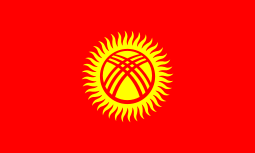
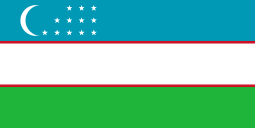
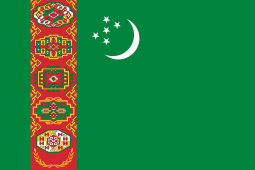
- Caspian Sea - railhead 1,520 mm
The strategy of transport development in Kazakhstan until 2015 is to build 1,600 km (990 mi) of new electrified and 2,700 km (1,700 mi) of existing railway stations.
The Khorgos Gateway dry port is one of Kazakhstan's primary dry ports for handling trans-Eurasian trains, which travel more than 9,000 km between China and Europe. The Khorgos Gateway dry port is surrounded by Khorgos Eastern Gate SEZ that officially commenced operations in December 2016.[8]
In 2006, a standard gauge rail link from China to Europe was proposed.[9]
In 2007, it was proposed to eliminate break of gauge at Druzhba-Alashankou by converting the Kazakhstan main line to European gauge.
In 2008, BOOT line from Zhetigen to Khorgos on the China border.[10] The line would branch off the existing railway near Shaquanzi.
Maps
Towns served by rail
Rapid transit and tram systems
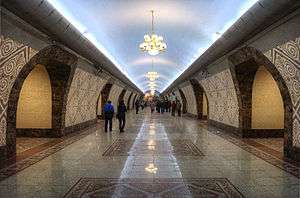
Almaty
There is a small (8.56 km (5.32 mi)) metro system in Almaty, the former capital and the largest city in the country. Second and third metro lines are planned in the future. The second line would intersect with the first line at Alatau and Zhibek Zholy stations.[11]
In May 2011, the construction of the second phase of the Almaty Metro line 1 began. The general contractor is Almatymetrokurylys. The extension includes five new stations, and will connect the downtown area of Almaty with Kalkaman in the suburbs. Its length will be 8.62 km (5.36 mi).[12]
The construction is divided into three phases. The first phase, the addition of the two stations Sairan and Moscow with a length of 2.7 km (1.7 mi)[12] opened in 2015.
There was a tram system of 10 lines which operated from 1937 to 2015.[13]
Nur-Sultan
A metro system is currently under construction in Nur-Sultan, the capital city.
The metro line had been a long time coming and the project was abandoned at one point in 2013,[14] but an agreement was signed on 7 May 2015 for the project to go ahead.[15]
Oskemen
In Oskemen, a tram system was operated until 2018.[16] Opened between 1959 and 1978, the tram was a popular form of transport in Oskemen/Ust-Kamenogorsk. At its peak, it had six routes, but in the end it had four routes in operation. It had a fleet of 50 working tram cars.[17]
Pavlodar
In Pavlodar, there is a 86 km (53 mi) tram network which began service in 1965. As of 2012, the network has 20 regular and three special routes. The network has a 60% share of the local public transport market. Its fleet of 115 trams are due to be replaced and in 2012, with the city announcing plans to purchase 100 new trams.[18]
Highways
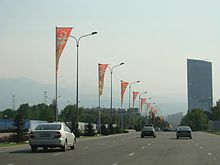
Kazakhstan has a road network stretching over 96,000 km (60,000 mi), most of which is in need of modernization and repair. It is, however, notable for containing the easterly terminus of European route E40, which contains the most easterly section of the Euroroute network.
- Total: 189,000 kilometres (117,000 mi) (2002)[20]
- Paved: 108,100 km (67,200 mi) (2002)
- Unpaved: 80,900 km (50,300 mi) (2002)
It is stated in the CIA Factbook that Kazakhstan has a total road network of 93,612 km (58,168 mi) which is made up of 84,100 km (52,300 mi) paved and 9,512 km (5,910 mi) unpaved roads (2008).[2]
As of 2017, there were 3,845,301 registered cars and a total of 4,425,770 units of autotransport.[21][22]
Five international routes pass through Kazakhstan, totaling 23,000 km (14,000 mi). These highways are:
- M-36 Highway: Almaty – Nur-Sultan – Kostanay (continues to Chelyabinsk)
- Almaty – Petropavl to Omsk with the release of
- M-38 Highway: Almaty - Semey - Pavlodar (continues to Omsk)
- M-39 Highway: Almaty - Shymkent (continues to Tashkent)
- M-32 Highway: Shymkent - Aktobe - Oral (continues to Samara)
In 2009, the country began the construction of the "Western Europe - Western China" highway, which will be completed by 2013. The total length of the road will be 8,445 km (5,247 mi), of which 2,787 km (1,732 mi) will be in Kazakhstan (Aktobe, Kyzylorda, South Kazakhstan, Zhambyl and Almaty oblasts). The thickness of the asphalt and concrete pavement will be 80 cm (31 in), and the expected lifespan of the highway will be 25 years, without a major overhaul, and the maximum speed limit 120 km/h (75 mph). The project includes a number of bridges over rivers, road maintenance facilities, bus stop areas, avtopavilony, cattle trails, and electronic signage. Simultaneously with the construction of this highway, roads will be repaired and built in areas along its route.[23][24][25]
Motorways
The motorway network in Kazakhstan is rather underdeveloped, mainly due to the low population density in the country, which doesn't require wider roads on long distances. There is a total of 490 km of motorways. The following are the only existing multi-lane, double carriage roads in Kazakhstan:
- A1 - Runs from Nur-Sultan to Shchuchinsk. It further continues as the A1 two-lane highway to Kokshetau. Motorway length: 250 km (160 mi).
- A2 - Runs from Almaty to a point past Uzynagash. It further continues as the A2 two-lane highway to Shymkent. Motorway length: 58 km (36 mi).
- A2 - Other four-lane portion runs from Shymkent to Zhibek Zholy, on the border with Uzbekistan. Length: 100 km (62 mi).
- A3 - Runs from Almaty to Kapshagay. It further continues as the A3 two-lane highway to Oskemen. Motorway length: 82 km (51 mi).
Pipelines
As of 2010, pipelines in Kazakhstan consist of:[2]
- Condensate: 658 km (409 mi)
- Gas: 12,317 km (7,653 mi)
- Oil: 11,201 km (6,960 mi)
- Refined products: 1,095 km (680 mi)
- Water, 1,465 km (910 mi)
Waterways and waterborne transportation
There are 4,000 km (2,500 mi) of waterways on the Syrdariya (Syr Darya), 80%, and Ertis (Irtysh) rivers, (2010)[2]
Ports and harbors
Merchant Marine
The merchant marine has a total of 119 vessels as of 2017 consisting of four general cargo vessels, ten petroleum tankers, and 105 other vessels.[26]
Airports
Kazakhstan has a total of 97 airports. (2012)[2] However, it is quoted as having a total of 449 airports in 2001.[20]
The large area of the country and the associated long distances makes air travel a very important component in domestic travel.
Airports - with paved runways
total: 64[2]
- over 3,047 metres (9,997 ft): 10
- 2,438–3,047 metres (7,999–9,997 ft): 25
- 1,524–2,437 metres (5,000–7,995 ft): 16
- 914–1,523 metres (2,999–4,997 ft): 5
- under 914 metres (2,999 ft): 8 (2012)
Airports - with unpaved runways
total: 33[2]
- over 3,047 metres (9,997 ft): 5
- 2,438–3,047 metres (7,999–9,997 ft): 7
- 1,524–2,437 metres (5,000–7,995 ft): 3
- 914–1,523 metres (2,999–4,997 ft): 5
- under 914 metres (2,999 ft): 13 (2012)
Open Sky regime
11 airports of Kazakhstan are part of the open sky regime, which allows more foreign carriers and more flights to operate at Kazakh airports. They include the airports of Nur-Sultan, Almaty, Shymkent, Aktau, Karaganda, Ust-Kamenogorsk, Pavlodar, Kokshetau, Taraz, Petropavlovsk, and Semey.[27]
Heliports
Total: 3 (2012)[2]
Airlines
The European Commission blacklisted all Kazakh carriers in 2009, with the sole exception of Air Astana. Since then, Kazakhstan had consistently been taking measures to modernize and revamp its air safety oversight. Thus, in 2016, the European Aviation Safety Agency removed all Kazakh airlines from its blacklist citing “sufficient evidence of compliance” with international standards by Kazakh airlines and its Civil Aviation Committee.[28]
- Air Astana - Air Astana (Эйр Астана) is the principal airline and the flag carrier of the Republic of Kazakhstan, based in Almaty, Kazakhstan.[29] It operates scheduled domestic and international services on 56 routes from its main hub, Almaty International Airport, and from its 2 secondary hubs, Astana International Airport and Atyrau Airport. It is a joint venture between Kazakhstan's sovereign wealth fund Samruk-Kazyna (51%), and BAE Systems PLC (49%). It was incorporated in October 2001, and started commercial flights on 15 May 2002. At the 2012 World Airline Awards held at Farnborough Airshow in the UK, Air Astana was named the Best Airline in Central Asia & India.[30]
- FlyArystan - low-cost subsidiary of Air Astana
- SCAT Airlines
- Sunday Airlines - charter subsidiary of SCAT Airlines
- Qazaq Air
- Caspiy
- Kaz TransAir
- Sigma Airlines
- Sunkar Air
The New Silk Road
Kazakhstan is actively involved in the New Silk Road initiative, which is an infrastructure project expected to significantly accelerate and reduce the cost of goods delivery from China to Europe through Central Asia.[31]
External links
| Wikimedia Commons has media related to Transport in Kazakhstan. |
References
- "A Conversation with H.E. Kairat Umarov, Ambassador of Kazakhstan" (PDF). Cftni.org. Archived from the original (PDF) on 2015-07-09.
- "The World Factbook — Central Intelligence Agency". www.cia.gov. Retrieved 25 September 2017.
- "Loco manufacturer obtains first IRIS certification in Kazakhstan". www.railwaygazette.com.
- "Alstom inaugurated first locomotive repairing centre in Kazakhstan". www.raillynews.com.
- "China's one-track mind in Kazakhstan". Policy Forum. 2018-02-13. Retrieved 2019-02-19.
- "Astana Nurly Zhol station inaugurated". www.railjournal.com.
- "Transit of goods through Kazakhstan grew 23 percent in 2019". The Astana Times.
- Shepard, Wade (2017-02-20). "Khorgos: The New Silk Road's Central Station Comes To Life". forbes.com.
- "KAZAKHSTAN - Temir Zholy". Archived from the original on 20 November 2008. Retrieved 25 September 2017.
- "ENRC to develop and operate the Zhetigen-Khorgos railway line between Kazakhstan and China - International Mining". 20 May 2008. Retrieved 25 September 2017.
- "urbanrail.net". Archived from the original on 25 April 2015. Retrieved 25 September 2017.
- "Алматыметро :: Главная страница". Archived from the original on 15 August 2012. Retrieved 25 September 2017.
- "Subways and Trams In Kazakstan: Almaty's Metro". www.subways.net. Retrieved 25 September 2017.
- "No Light Rail Transport for Astana". Tengrinews.kz. Retrieved 25 September 2017.
- UK, DVV Media. "Astana light rail framework agreement signed". Retrieved 25 September 2017.
- "В Усть-Каменогорске полностью остановили движение трамваев" [The tram system in Ust-Kamenogorsk completely ceased operation] (in Russian). Informburo. 2018-03-12. Retrieved 2018-03-15.
- "Усть-Каменогорский трамвай :: Введение". oskemen-tramway.narod.ru. Retrieved 25 September 2017.
- Pavlodar
- "temirtau.kz - главный сайт Темиртау". Archived from the original on 8 January 2014. Retrieved 25 September 2017.
- "Transportation - Kazakhstan - infrastructure". www.nationsencyclopedia.com. Retrieved 25 September 2017.
- «Казинформ»(Kazinform )
- "Усть-Каменогорск Всё больше". www.yk.kz. Retrieved 25 September 2017.
- "ЗАПАДНАЯ ЕВРОППА И ЗАПАДНЫЙ КИТАЙ ВСТРЕЧАЮТСЯ НА ЗЕМЛЕ СЫРА - 1 Января 2011 - ОФИЦИАЛЬНЫЙ САЙТ ГАЗЕТЫ "КЫЗЫЛОРДИНСКИЕ ВЕСТИ"". kv.ucoz.kz. Retrieved 25 September 2017.
- "Новости Казахстана - свежие, актуальные, последние новости об о всем". kazpravda.kz. Archived from the original on 9 July 2012. Retrieved 25 September 2017.
- "Западная Европа - Западный Китай Международный Транзитный коридор". europe-china.kz. Retrieved 25 September 2017.
- "The World Factbook". cia.gov. 7 June 2018. Kazakhstan. Retrieved 22 June 2018.
- "Kazakhstan adopts open skies regime at 11 airports starting Nov. 1". The Astana Times.
- "Sustained safety effort pulled Kazakhstan off EU blacklist". www.flightglobal.com.
- "Head Office Archived 2012-07-17 at Archive.today." Air Astana. Retrieved on 21 December 2010. "Registered office 4A, Zakarpatskaya Street, Almaty, 050039, Kazakhstan"
- "Air Astana named Best Airline in Central Asia & India". The Gazette of Central Asia. Satrapia. 17 July 2012. Retrieved 20 July 2012.
- "Kazakhstan turns geography to advantage as China builds a "New Silk Road"". www.economist.com.
![]()
